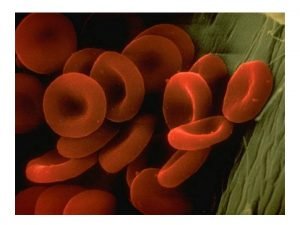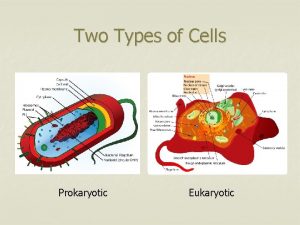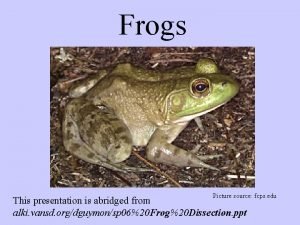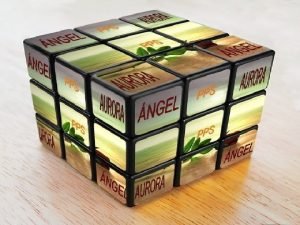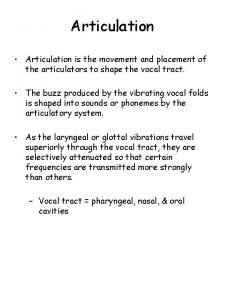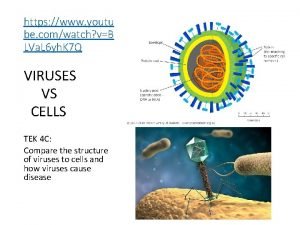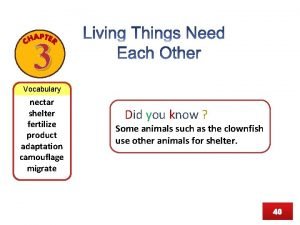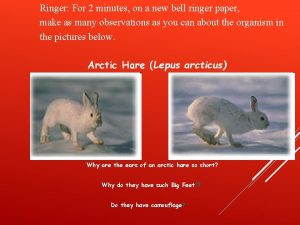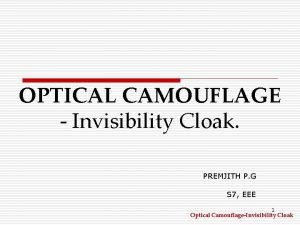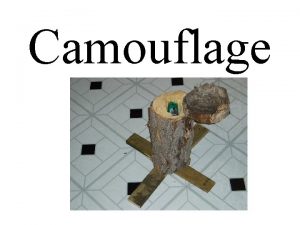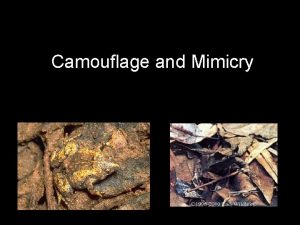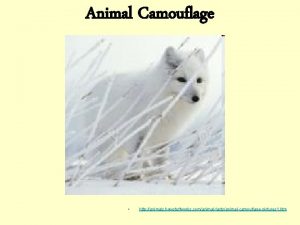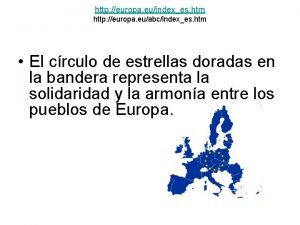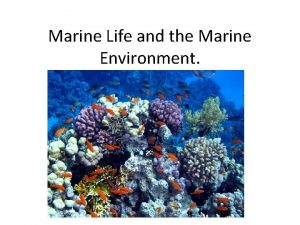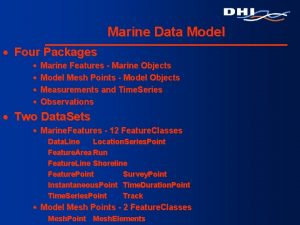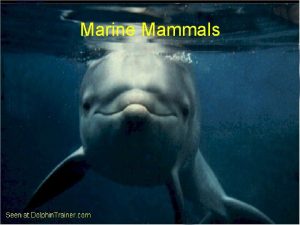http www msstarship comsciencenewcamouflage htm Marine Camouflage Hiding




























- Slides: 28

http: //www. ms-starship. com/sciencenew/camouflage. htm Marine Camouflage Hiding in Plain Sight

Kill or Be Killed • Most animals either have to pursue their food, or evade other animals that are pursuing them as food. • Some have responded by developing more efficient forms of locomotion • Others have developed deterrents in the way of spines or toxic secretions • Still others have become ‘masters of camouflage’, blending perfectly with their surrounding environment




‘Hunting or Hiding’ • Hunting – Enables predators to get closer to prey – Compensation for slow locomotion etc. • Hiding – “Crypsis”: resemblance to ones background – usually involves an animal taking on the colour of its surroundings – Sessile (non-moving) creatures which live in one environment often have fixed coloration and markings to suit their particular micro-habitat – mobile organisms need to be able to change their colors at will as they move across varying colored backgrounds

The Mechanics of Color Change: Color Cells • Chromatophores. – Chromatophores are cells containing pigments that are controlled or stimulated by either nerves or hormones. – Layers of differently pigmented chromatophores effectively produce different colors, responsible for the myriad combinations of hues we see in tropical reef fish. • iridophores – which reflect light and produce a mirror effect, are responsible for the silvery sheen of many ‘mid-water’ fish species.




More Cells • Photophores – produce light, and which are used by some cephalopods to prevent predators from picking out their silhouette against a sunlit surface. By illuminating their underside their own shadow is eliminated, an effective camouflage technique known as counter illumination.


Colour for Camouflage • Countershading; use color rather than light to achieve the same effect. The dorsal (upper) surface of such fish is a dark color that when seen from above blends with the blue of deep water, whereas the ventral (underside) is white to merge with the bright surface light apparent from below. • Fish such as Flounder and Scorpion fish not only change their color, but also their pattern to match the background perfectly. Certain Pipefish and Frogfish also have small fleshy protuberances on their body that can mimic the algae’s (seaweeds) they hide amongst. Without a doubt though, it is the cephalopods that are the real masters of color change, being able to change color and pattern in seconds, and having an immense range of hues available to them.

More Color Tricks • Disruptive coloration – Certain diurnal (daytime) species that ‘rest’ at night, adopt blotchy coloration during the hours of darkness which helps break up their outline; Bold stripes or patterns effectively break up the shape of the fish making them hard to pick out from the background. • Light levels – also affect the use of color for camouflage; – often nocturnal or deepwater fish species are red in color, as this is the first color of the spectrum to disappear when light levels drop. Because of this, at depth red appears ‘dark’, and is hard to pick out in the gloomy light.


Eye spots • imitation eyes • Predatory fish often fixate on the eyes of their prey to determine their intentions and flight-path. • Some prey species have dark patches or stripes across their eyes (‘eyebars’) to make them less obvious, and an ‘eyespot’ near the rear of their body. This may cause the predator to misjudge the direction of the prey fishes flight; or at worst attack the less ‘vital’ end of the animal. • Large prominent eyespots may actually deter a predator altogether by causing an overestimation of the prey’s size.

Warning Coloration • Another way color is used for protection in the marine environment is as a warning to would be predators that the owner is dangerous, toxic, or inedible. Species employing this strategy include most Nudibranchs, (sea-slugs), the Lionfish, sea snakes, and several species of Cone shell to name but a few.

Scent Camouflage • There is a species of Parrotfish that has gone a step further than just visual camouflage; the Queen Parrotfish actually surrounds itself with a transparent mucous cocoon, which is secreted from its mouth. This effectively hides its scent from nighttime predators that rely on scent, such as moray eels.


• Squid, Octopus and Cuttlefish also use a type of ‘scent camouflage’. All share the ability to squirt a blob of ink in defense, which as well as acting as a ‘smoke screen’, is believed to inhibit the sense of smell in predators

Using What’s Around • Areas of ‘muck’ and detritus often yield some of the most interesting examples of camouflage amongst marine organisms; spiny, tassellated fish such as the Crocodilefish, leaf-shaped species like the Cockatoo Waspfish, and a host of bizarre crustaceans…spider crabs, decorator crabs, etc. • The latter species actually utilize bits of their background environment to camouflage themselves, attaching small sponges or seaweeds to their carapace making them doubly hard to distinguish!


Morphology; or ‘Body Shape Camouflage’ • To blend most effectively with their surroundings, animals often have a modified body shape; for example on flat sandy bottoms we find the flounder, a fish species that is so laterally flattened as to appear run over by a steamroller!


Morphology • The flounder’s body shape is adapted to its benthic environment to the extent that both eyes have migrated to one side of their body, (the ‘top’), and the mouth is on the other, (‘the bottom’) … allowing this species to lie flush on a sandy substrate with only its darting eyes giving it away. • Ghost pipefish on the other hand have a thin, more cylindrical body, which is particularly suited to their habitat of seagrasses, vegetation, and debris. • Razorfish, have a thin, very flattened body that it holds in a vertical position. When amongst seagrass it becomes virtually invisible. • Octopus are capable of changing its body shape to resemble a pile of rocks, a sandy hump … or whatever shape is requires to blend into its background.


Camouflage and ‘Balance’ • Obviously what is suitable camouflage for one habitat is inappropriate for another, however nature has a way of ‘getting it right’, and only those whose camouflage is effective will survive to propagate their species. • Evolutionary progression will see to it that the ‘arms race’ between hunters and hunted will continue giving rise to more weird and wonderful camouflage adaptations; while throughout that process a ‘balance’ is maintained. In the natural order of things competition results in innovation and biodiversity rather than extinction … that is, barring interference from Man.

New Vocabulary • benthic, bottom dwelling carapace, external skeleton covering body cephalopods, squids, octopus and cuttlefish crustaceans, crabs, shrimps detritus, rubbish diurnal, active during the night dorsal, upper surface elasmobranches, sharks and rays gastropods the phylum to which shellfish and cephalopods belong morphological, relating to the body nocturnal, active at night phyla. Primary subdivision of taxonomic classification sessile, not moving substrate, bottom material tasselated, having small skin tassels toxic, poisonous ventral, lower surface or underside
 North south east west globe
North south east west globe Plant cell
Plant cell Taiga plants and adaptations
Taiga plants and adaptations Http://www.cellsalive.com/howbig.htm
Http://www.cellsalive.com/howbig.htm Http://www.tvdsb.on.ca/westmin/science/snc2g1/frogresp.htm
Http://www.tvdsb.on.ca/westmin/science/snc2g1/frogresp.htm Brainpop mitosis
Brainpop mitosis How is meiosis different in males and females
How is meiosis different in males and females Fibonacci fächer
Fibonacci fächer Http://www.cellsalive.com
Http://www.cellsalive.com Http://www.cellsalive.com/mitosis.htm
Http://www.cellsalive.com/mitosis.htm Http://www.innerbody.com/htm/body.html
Http://www.innerbody.com/htm/body.html What are the different types of tundra biomes
What are the different types of tundra biomes Cielo triste
Cielo triste Isaac newton
Isaac newton Http //elements.wlonk.com/elements table.htm
Http //elements.wlonk.com/elements table.htm Inclined planes examples
Inclined planes examples Http://www.innerbody.com/htm/body.html
Http://www.innerbody.com/htm/body.html Http://mbgnet.mobot.org/
Http://mbgnet.mobot.org/ Http://www.blueplanetbiomes.org/world_biomes.htm
Http://www.blueplanetbiomes.org/world_biomes.htm L
L Htp.vtaide.com
Htp.vtaide.com Cells alive meiosis
Cells alive meiosis What is the difference between mimicry and camouflage
What is the difference between mimicry and camouflage Camouflage
Camouflage Bamboozle comparative and superlative
Bamboozle comparative and superlative Camouflage is one way animals protect themselves
Camouflage is one way animals protect themselves Camouflage animals
Camouflage animals Optical camouflage technology
Optical camouflage technology Turkey disguise project pig
Turkey disguise project pig

